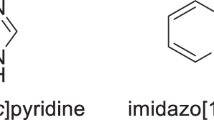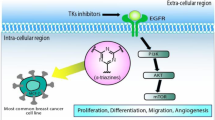Abstract
This study described the bioactivity and the structure-activity relationship (SAR) of newly synthesized chromone derivatives against triple-negative breast cancer (TNBC) MDA-MB-231 cells. Among the compounds tested, C8 exerted a growth inhibitory effect on the TNBC-derived MDA-MB-231 cells with an IC50 value of 11.71 ± 0.79 µM. Results showed that it could promote apoptosis, sensitize TNBC MDA-MB-231 cells to doxorubicin (Dox) and inhibit multiple kinase activities with higher selectivity against PIM1 and PIM2 kinases. Molecular docking results revealed compound C8 engaged in several critical interactions with the important residues in PIM1 and PIM2 binding sites. This suggests that compound C8 possessed anticancer activity on TNBC cells potentially mediated by inhibition of multiple tyrosine kinases and kinases involved in cell-cycle regulation.









Similar content being viewed by others
References
World Health Organization. WHO report on cancer: Setting priorities investing wisely and providing care for all. 2020.
Lin Y, Liu R, Zhao P, et al. Discovery of novel mifepristone derivatives via suppressing KLF5 expression for the treatment of triple-negative breast cancer. Eur J Med Chem. 2018;146:354–67.
Zhang CH, Chen K, Jiao Y, et al. From lead to drug candidate: optimization of 3-(Phenylethynyl)-1H-pyrazolo[3,4-d]pyrimidin-4-amine derivatives as agents for the treatment of triple negative breast cancer. J Med Chem. 2016;59:9788–805.
Cao W, Li J, Hao Q, Vadgama JV, Wu Y. AMP-activated protein kinase: a potential therapeutic target for triple-negative breast cancer. Breast Cancer Research. 2019;21:1–10.
Ataseven B, Frindte J, Harter P, et al. Perception of side effects associated with anticancer treatment in women with breast or ovarian cancer (KEM-GO-1): a prospective trial. Support Care Cancer. 2019. https://doi.org/10.1007/s00520-019-05216-y.
O’Reilly EA, Gubbins L, Sharma S, et al. The fate of chemoresistance in triple negative breast cancer (TNBC). BBA Clin. 2015;3:257–75.
Sun T, Aceto N, Meerbrey KL, et al. Activation of multiple proto-oncogenic tyrosine kinases in breast cancer via loss of the PTPN12 phosphatase. Cell. 2011. https://doi.org/10.1016/j.cell.2011.02.003.
Kaboli PJ, Imani S, Jomhori M, Ling K-H. Chemoresistance in breast cancer: PI3K/Akt pathway inhibitors vs the current chemotherapy. Am J Cancer Res. 2021;11:5155–83.
Peng Y, Wang Y, Zhou C, Mei W, Zeng C. PI3K/Akt/mTOR pathway and its role in cancer therapeutics: are we making headway? Front Oncol. 2022;12:1–17.
Kohlmeyer JL, Gordon DJ, Tanas MR, Monga V, Dodd RD, Quelle DE. CDKs in sarcoma: mediators of disease and emerging therapeutic targets. Int J Mol Sci. 2020;21:1–30.
Ding L, Cao J, Lin W, Chen H, Xiong X, Ao H, et al. The roles of cyclin-dependent kinases in cell-cycle progression and therapeutic strategies in human breast cancer. Int J Mol Sci. 2020;21:1–28.
Braicu C, Buse M, Busuioc C, Drula R, Gulei D, Raduly L. et al. A comprehensive review on MAPK: a promising therapeutic target in cancer. Cancer. 2019;11:1618.
Chen J, Tang G. PIM-1 kinase: a potential biomarker of triple-negative breast cancer. Onco Targets Ther. 2019;12:6267–73.
Panchal NK, Sabina EP. A serine/threonine protein PIM kinase as a biomarker of cancer and a target for anti-tumor therapy. Life Sci. 2020;255:117866.
Brasó-Maristany F, Filosto S, Catchpole S, et al. PIM1 kinase regulates cell death, tumor growth and chemotherapy response in triple-negative breast cancer. Nat Med. 2016;22:1303–13.
Duan YD, Jiang YY, Guo FX, Chen LX, Xu LL, Zhang W, et al. The antitumor activity of naturally occurring chromones: a review. Fitoterapia. 2019;135:114–29.
Xiao Y, Liu Y, Gao Z, Li X, Weng M, Shi C, et al. Fisetin inhibits the proliferation, migration and invasion of pancreatic cancer by targeting PI3K/AKT/mTOR signaling. Aging. 2021;13:24753–67.
Chen P, Wen X, Wang B, Hou D, Zou H, Yuan Q. et al. PI3K/Akt inhibitor LY294002 potentiates homoharringtonine antimyeloma activity in myeloma cells adhered to stromal cells and in SCID mouse xenograft. Ann Hematol. 2018;97:865–75.
Cai J, Qian K, Zuo X, Yue W. PLGA nanoparticle-based docetaxel/LY294002 drug delivery system enhances antitumor activities against gastric cancer. J Biomater Appl. 2019;33:1394–1406.
Sekino Y, Han X, Kawaguchi T, Babasaki T, Goto K. TUBB3 reverses resistance to docetaxel and cabazitaxel in prostate cancer. Int J Mol Sci. 2019;20:3936.
Xu R, Zhang Y, Li A, Ma Y, Cai W. LY 294002 enhances the chemosensitivity of liver cancer to oxaliplatin by blocking the PI3K/AKT/HIF 1 α pathway. Mol Med Rep. 2021;24:508.
Yu L, Shang Z, Hsu F, Zhang Z, Tumati V, Lin Y, et al. NSCLC cells demonstrate differential mode of cell death in response to the combined treatment of radiation and a DNA- PKcs inhibitor. Oncotarget. 2015;6:3848–60.
Hou G, Zhao Q, Zhang M, Fan T, Liu M, Shi X, et al. Down-regulation of Rictor enhances cell sensitivity to PI3K inhibitor LY294002 by blocking mTORC2-medicated phosphorylation of Akt/PRAS40 in esophageal squamous cell carcinoma. Biomed Pharmacother. 2018;106:1348–56.
Redwan IN, Dyrager C, Solano C, Fernández De Trocóniz G, Voisin L, Bliman D, et al. Towards the development of chromone-based MEK1/2 modulators. Eur J Med Chem. 2014;85:127–38.
Ibrahim N, Bonnet P, Brion JD, et al. Identification of a new series of flavopiridol-like structures as kinase inhibitors with high cytotoxic potency. Eur J Med Chem. 2020;199:1–14.
Chen MB, Zhou ZT, Yang L, Wei MX, Tang M, Ruan TY, et al. KU-0060648 inhibits hepatocellular carcinoma cells through DNA-PKcs-dependent and DNA-PKcs-independent mechanisms. Oncotarget. 2016;7:17047–59.
Holder S, Zemskova M, Zhang C, Tabrizizad M, Bremer R, Neidigh JW, et al. Characterization of a potent and selective small-molecule inhibitor of the PIM1 kinase. Mol Cancer Ther. 2007;6:163–72.
Park C, Cha H, Lee H, Hwang-bo H, Ji SY, Jin C. et al. Induction of G2/M cell cycle arrest and apoptosis by genistein in human bladder cancer T24 cells through inhibition of the ROS-dependent PI3k/Akt signal transduction pathway. Antioxidants. 2019;8:327
Zhang L, Zhuang Y, Tu G, Li D, Fan Y, Ye S, et al. Positive feedback regulation of Poly(ADP-ribose) polymerase 1 and the DNA-PK catalytic subunit affects the sensitivity of nasopharyngeal carcinoma to etoposide. ACS Womega. 2022;7:2571–82.
Chen KTJ, Militao GGC, Anantha M, Witzigmann D, Leung AWY, Bally MB. Development and characterization of a novel flavopiridol formulation for treatment of acute myeloid leukemia. Journal of Controlled Release. 2021;333:246–57.
Dey J, Deckwerth TL, Kerwin WS, et al. Voruciclib, a clinical stage oral CDK9 inhibitor, represses MCL-1 and sensitizes high-risk Diffuse Large B-cell Lymphoma to BCL2 inhibition. Sci Rep. 2017;7:1–11.
Zhu ML, Zhang PM, Jiang M, Yu SW, Wang L. Myricetin induces apoptosis and autophagy by inhibiting PI3K/Akt/mTOR signalling in human colon cancer cells. BMC Complement Med Ther. 2020;20:209.
Lang SJ, Schmiech M, Hafner S, Paetz C, Werner K, Gaafary ME, et al. Chrysosplenol d, a flavonol from artemisia annua, induces erk1/2-mediated apoptosis in triple negative human breast cancer cells. Int J Mol Sci. 2020;21:1–19.
Tuli HS, Tuorkey MJ, Thakral F, Sak K, Kumar M, Sharma AK, et al. Molecular mechanisms of action of genistein in cancer: recent advances. Front Pharmacol. 2019;10:1–16.
Bhat SS, Prasad SK, Shivamallu C, Prasad KS, Syed A, Reddy P, et al. Genistein: a potent anti-breast cancer agent. Curr Issues Mol Biol. 2021;43:1502–17.
Rullah K, Mohd Aluwi MFF, Yamin BM, et al. Molecular characterization, biological activity, and in silico study of 2-(3,4-dimethoxyphenyl)-3-(4-fluorophenyl)-6-methoxy-4H-chromen-4-one as a novel selective COX-2 inhibitor. J Mol Struct. 2015;1081:51–61.
Singh M, Kaur M, Vyas B, Silakari O. Design, synthesis and biological evaluation of 2-Phenyl-4H-chromen-4-one derivatives as polyfunctional compounds against Alzheimer’s disease. Med Chem Res. 2018;27:520–30.
Chen D, Guo D, Yan Z, Zhao Y. Allenamide as a bioisostere of acrylamide in the design and synthesis of targeted covalent inhibitors. Medchemcomm. 2018;9:244–53.
Di Veroli GY, Fornari C, Wang D, Mollard S, Bramhall JL, Richards FM, et al. Combenefit: an interactive platform for the analysis and visualization of drug combinations. Bioinformatics. 2016;32:2866–8.
Chao CT. Preclinical versus clinical drug combination studies. Leuk Lymphoma. 2008;49:2059–80.
Safi A, Heidarian E, Ahmadi R. Quercetin synergistically enhances the anticancer efficacy of docetaxel through induction of apoptosis and modulation of PI3K/AKT, MAPK/ERK, and JAK/STAT3 signaling pathways in MDA-MB-231 breast cancer cell line. Int J Mol Cell Med. 2021;10:1–12.
Wu D, Tao J, Xu B, Qing W, Li P, Lu Q, et al. Phosphatidylinositol 3-kinase inhibitor LY294002 suppresses proliferation and sensitizes doxorubicin chemotherapy in bladder cancer cells. Urologia International. 2011;86:346–54.
Alikarami F, Safa M, Faranoush M, Hayat P. Inhibition of DNA-PK enhances chemosensitivity of B-cell precursor acute lymphoblastic leukemia cells to doxorubicin. Biomed. Pharmacother. 2017;94:1077–93.
Zeidner JF, Lee DJ, Frattini M, Fine GD, Costas J, Kolibaba K, et al. Phase I study of alvocidib followed by 7 + 3 (cytarabine + daunorubicin) in newly diagnosed acute myeloid leukemia. Clin Cancer Res. 2021;27:60–69.
Li S, Yuan S, Zhao Q, Wang B, Wang X, Li K. Quercetin enhances chemotherapeutic e ff ect of doxorubicin against human breast cancer cells while reducing toxic side effects of it. Biomed Pharmacother. 2018;100:441–7.
Lv L, Liu C, Chen C, Yu X, Chen G. Quercetin and doxorubicin co-encapsulated biotin receptor- targeting nanoparticles for minimizing drug resistance in breast cancer. Oncotarget. 2016;7:32184–99.
Shu YAN, Xie BO, Liang Z, Chen J. Quercetin reverses the doxorubicin resistance of prostate cancer cells by downregulating the expression of c-met. Oncol Lett. 2018;15:2252–8.
Sun X, Li Y, Xu L, Shi X. Heparin coated meta-organic framework co-delivering doxorubicin and quercetin for effective chemotherapy of lung carcinoma. J Int Med Res. 2020;48:1–13.
Zhao YQ, Yin YQ, Liu J, Wang GH, Huang J, Zhu LJ, et al. Characterization of HJ-PI01 as a novel Pim-2 inhibitor that induces apoptosis and autophagic cell death in triple-negative human breast cancer. Acta Pharmacol Sin. 2016;37:1237–50.
Ishchenko A, Zhang L, Le Brazidec JY, et al. Structure-based design of low-nanomolar PIM kinase inhibitors. Bioorg Med Chem Lett. 2015;25:474–80.
Jacobs MD, Black J, Futer O, Swenson L, Hare B, Fleming M, et al. Pim-1 ligand-bound structures reveal the mechanism of serine/threonine kinase inhibition by LY294002. J Biol Chem. 2005;280:13728–34.
Huang X, Miller W. A time-efficient, linear-space local similarity algorithm. Adv Appl Math. 1991;12:337–57.
Wang L, Li P, Wu Z, Yan J, Wang M, Ding Y. Reduction of nitroarenes to aromatic amines with nanosized activated metallic iron powder in water. Synthesis. 2003. https://doi.org/10.1055/s-2003-41021.
Yen KP, Stanslas J, Zhang T, Li H, Wang X, Meng CK. et al. Synthesis of small molecules targeting paclitaxel-induced MyD88 expression in triple-negative breast cancer cell lines. Bioorg Med Chem. 2021;49:116442.
Hii LW, Lim SHE, Leong CO, Chin SY, Tan NP, Lai KS, et al. The synergism of Clinacanthus nutans Lindau extracts with gemcitabine: downregulation of anti-apoptotic markers in squamous pancreatic ductal adenocarcinoma. BMC Complement Altern Med. 2019;19:1–13.
Trott, Olson AJ. AutoDock Vina: improving the speed and accuracy of docking with a new scoring function, efficient optimization, and multithreading. J Comput Chem. 2010;31:455–61.
Acknowledgements
This work was financially supported by GUP-2020-006 Universiti Kebangsaan Malaysia (UKM).
Author information
Authors and Affiliations
Corresponding author
Ethics declarations
Conflict of interest
The authors declare no competing interests.
Additional information
Publisher’s note Springer Nature remains neutral with regard to jurisdictional claims in published maps and institutional affiliations.
Supplementary information
Rights and permissions
Springer Nature or its licensor (e.g. a society or other partner) holds exclusive rights to this article under a publishing agreement with the author(s) or other rightsholder(s); author self-archiving of the accepted manuscript version of this article is solely governed by the terms of such publishing agreement and applicable law.
About this article
Cite this article
Islam, R., Yan, M.P., Yen, K.P. et al. Synthesis and biological evaluation of chromone derivatives against triple-negative breast cancer cells. Med Chem Res 32, 884–898 (2023). https://doi.org/10.1007/s00044-023-03048-4
Received:
Accepted:
Published:
Issue Date:
DOI: https://doi.org/10.1007/s00044-023-03048-4




